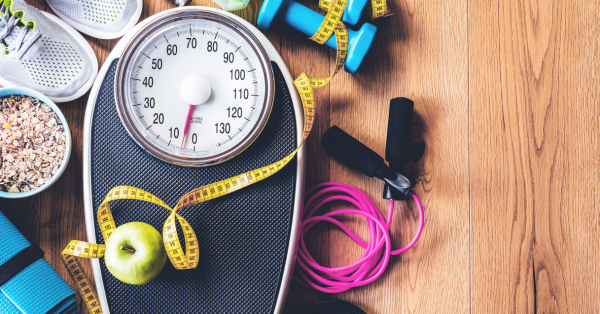Weight loss does not occur overnight. If you wish to control weight effectively in a safe and healthy way, you will have to change your eating habits and exercise regularly.
Reduce Calorie Intake
Obesity develops over time. When the calories consumed are more than what the body needs, these excess calories are stored as fat. Limiting one’s intake of calories not only helps to control body weight, but can also boost the immune system. Experimental studies have also shown that restricting calorie intake can prolong life span by about 30%.
Calories and Losing Weight
The number of calories an individual needs daily depends on factors such as height, weight, gender, age, and activity level. Find out how many calories are needed to maintain your weight from the table below.
| Activity Level | ||||
| Gender | Age (years) | Sedentary | Moderately Active | Active |
| Female | 19-30 31-50 51-75 76+ | 1,800-2,000 1,800 1,800 1,600 | 2,000-2,200 2,000 1,800 1,800 | 2,400 2,200 2,000-2,200 2,000 |
| Male | 19-30 31-50 51-75 76+ | 2,400-2,600 2,200-2,400 2,000-2,200 2,000 | 2,600-2,800 2,400-2,600 2,200-2,400 2,200 | 3,000 2,800-3,000 2,600-2,800 2,400 |
Source: U.S. Department of Health and Human Services and U.S. Department of Agriculture
Healthy weight loss occurs slowly and steadily. Aim to lose 0.5-1k kg a week. To do this, reduce your daily caloric intake by 500 to 1,000 calories, burn off that number of calories each day, or use a combination of a low-calorie diet and regular exercise.
For example, a 31 year-old female officer worker with a sedentary lifestyle needs about 1,800 calories daily to maintain her weight. To lose 0.5-1 kg per week, she will need to reduce her daily calorie intake by 500 to 1,000 calories or burn off this number of calories through exercise each day.
Calorie content of common foods
Many people do not know many calories are in the food and drinks they consume daily. This list provides the calories for common foods and daily.

| Item | Quantity | No. of Calories |
| Beverages | ||
| Milkshake | 1 big cup (946 ml) | 2,310 |
| Café | 1 cup (473 ml) | 190 |
| Beer | 1 can (356 g) | 153 |
| Cola | 1 can (330 ml) | 139 |
| Susu | 1 cup (200 ml) | 136 |
| Orange juice | 1 cup (248 g) | 112 |
| Apple juice | 1 cup (248 g) | 114 |
| Fast Food | ||
| Big Breakfast with Hot cakes consisting of butter milk biscuit, beef patty, scrambled egg, pancakes, and hash browns | 1 set | 1,150 |
| Double beef and bacon burger | 1 | 940 |
| Tuna sub sandwish | Regular serving | 790 |
| Cheese pizza | 2 large slices | 700 |
| Tuscani chicken alfredo pizza | 1/4 dish | 620 |
| Fried chicken breast | 1 | 520 |
| Fries | 1 large serving | 510 |
| Cooked Food | ||
| Cantonese fried noodles | 1 serving (266.5 g) | 490 |
| Rice, white, cooked | 1 bowl (180 g) | 252 |
| Fried egg | 1 (46 g) | 90 |
| Snacks | ||
| Chicken Caesar salad | 1 serving (462 g) | 740 |
| Chocolate sundae | 1 (333 g) | 570 |
| Cheesecake | 100 g | 321 |
| Condiments | ||
| Vegetable oil | 1 tbsp (14 g) | 119 |
| Sugar | 1 tsp (4 g) | 15 |
| Salt | 1 tbsp (18 g) | 0 |
| Ground white pepper | 1 tbsp (7 g) | 21 |
| Ketchup | 1 tbsp (15 g) | 15 |
| Chili sauce | 1 tbsp (15 ml) | 25 |
| Mayonnaise | 1 tbsp (14 g) | 37 |
| Mustard | 1 tsp (5 g) | 3 |
| Soy sauce | 1 tbsp (15 ml) | 10 |
Consume a Variety of Plant Foods
Foods that are high in fat and animal-based protein contain high amounts of calories, which can increase the risk of becoming obese. Instead of choosing fried food that is high in sugar, it is better to opt for low-calorie and high-nutrient vegetables, fruits, and boiled or steamed food.
Plant foods are not only low in calories, but they also come with high nutritional value and contain phytochemicals, antioxidants, and polysaccharides. These nutrients help to nourish the immune system and maintain good overall health.
Dietary fiber, found that only in plant foods, helps to maintain a healthy weight, prevent constipation, and lower the risk of diabetes and heart disease. Here is a list of the dietary fiber content in common foods:
| Makanan | Dietary Fiber Content (g) |
| Psyllium husk (100 g) | 78 |
| Oats (100 g) | 11 |
| Whole wheat bread (2 slices) | 4 |
| Orange (1 large) | 4 |
| Apple (1, medium unpeeled) | 4 |
| Brussels sprouts (100 g) | 3 |
| Broccoli (100 g) | 3 |
| Carrot (100 g) | 3 |
| Strawberries (100 g) | 2 |
| Blueberries (100 g) | 2 |
| Kiwi fruit (1, without skin, 76 g) | 2 |
| Brown rice (100 g) | 2 |
| Cooked white rice (100 g) | 0 |
Exercise Regularly
A healthy diet can help reduce one’s caloric intake. Exercise can help burn calories to aid weight loss and give the immune system a boost. Exercise can also improve cardiopulmonary function, help prevent coronary heart disease, and increase the flexibility of the body and joints. In addition, exercise is highly beneficial to the lymphatic system, as movement of muscles improves the flow of lymph fluid, thus boosting the immune system and helping to defend against diseases. Moderate exercise helps to deplete energy in the body, and this is helpful for weight loss goals. Be sure to include exercise as part of a healthy lifestyle. For example, try to take the stairs instead of the elevator. In addition to those sorts of small changes, do not spend more than 20 minutes sitting still and not getting any exercise. After 20 minutes, stretch out and relax the body.
The following table lists the number of calories burned per hour while doing different types of exercise, adjusted for different body weights:

| Activity (1 hour) | 59 kg | 70 kg | 82 kg |
| Bicycling, <10 mph, leisure | 236 | 281 | 327 |
| Ballroom dancing, fast | 325 | 387 | 449 |
| Hatha yoga | 236 | 281 | 327 |
| Swimming | 354 | 422 | 49 |
| Tai chi | 236 | 281 | 327 |
| Aerobics, general | 284 | 457 | 531 |
| Badminton, social | 266 | 317 | 368 |
| Basketball, nongame | 354 | 422 | 490 |
| Bowling | 177 | 211 | 245 |
| Running, 5 mph | 472 | 563 | 654 |
| Running up stairs | 885 | 1,056 | 1,226 |
| Soccer | 413 | 493 | 572 |
| Squash | 708 | 844 | 981 |
| Table tennis, ping pong | 236 | 281 | 327 |
| Tennis | 413 | 493 | 572 |
| Walking, 4 mph, very brisk pace | 295 | 352 | 409 |
Tips for Safe, Effective Weight Loss
- Drink water and eat high-fiber fruits and vegetables before meals. This ensures that your body is hydrated and receives the nutrients it needs most first. You will also feel fuller before you start your meal and will eat less.
- Start your meal by drinking soup before eating rice and side dishes.
- Get enough sleep – your body burns calories during sleep.
- Try to avoid oil when cooking. Each tablespoon of vegetables oil contains approximately 120 calories!

